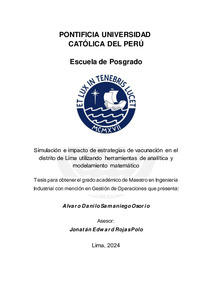| dc.contributor.advisor | Rojas Polo, Jonatan Edward | |
| dc.contributor.author | Samaniego Osorio, Alvaro Danilo | |
| dc.date.accessioned | 2024-04-17T16:25:33Z | |
| dc.date.available | 2024-04-17T16:25:33Z | |
| dc.date.created | 2024 | |
| dc.date.issued | 2024-04-17 | |
| dc.identifier.uri | http://hdl.handle.net/20.500.12404/27578 | |
| dc.description.abstract | La crisis global causada por el COVID19 ha resaltado la importancia de un manejo
estratégico de detección y control de epidemias para minimizar el número de personas
contagiadas y reducir el número de personas con complicaciones graves y posterior
muerte. La respuesta global ha surgido por tres vías: (1) contención (2) vacunación
masiva y (3) reforzamiento de instituciones de salud.
Por lo tanto, el objetivo de esta investigación es representar la dinámica de la epidemia
del COVID19 como un modelo de programación lineal que permita evaluar distintas
políticas basadas en algunas combinaciones de las tres vías antes mencionadas.
En el primer capítulo, se detallará el marco teórico y las herramientas matemáticas
usadas tales como la programación lineal y los sistemas de información geográfica, así
como también la descripción de una epidemia y/o pandemia y sus indicadores claves.
En el segundo capítulo, se describirán dos estudios de casos en los que se han aplicado
técnicas de modelamiento o de ecuaciones diferenciales parciales para definir
estrategias de vacunación en Estados Unidos y Australia.
En el tercer capítulo, se hará un breve diagnóstico de la situación actual vista como la
evolución temporal de las etapas del COVID19 en Perú incluyendo principales
indicadores, así como también la respuesta del país ante esta pandemia con la
adquisición de vacunas y la instalación de centros de vacunación.
En el cuarto capítulo, se realiza la conceptualización del modelo matemático a partir de
una adaptación del modelo compartimental SIR bajo diferentes supuestos que no
afectan la linealización del problema. Se presentará el modelo, el código utilizado, los
resultados del modelo y un análisis de sensibilidad respecto a los parámetros críticos.
En el quinto capítulo, se describirán las principales conclusiones derivadas del modelo
y de sus resultados, así como también su aplicabilidad a otras epidemias; asimismo, se
incluirán futuros alcances que podrían utilizar este trabajo de investigación como una
fuente primaria. | es_ES |
| dc.description.abstract | The global crisis caused by COVID19 has highlighted the importance of strategic
management of epidemic detection and control to minimize the number of infected and
to reduce the number of infected with severe complications and subsequent death. The
global response went by three pathways: (1) containment (2) mass vaccination and (3)
reinforcement of health institutions.
Therefore, the objective of this research is to represent the dynamics of the COVID19
epidemic as a linear programming model that allows the evaluation of different policies
based on some combinations of the three aforementioned pathways.
In the first chapter, the theoretical framework and the mathematical tools used such as
linear programming and geographic information systems will be detailed, as well as the
description of an epidemic and/or pandemic and its key indicators.
In the second chapter, two case studies will be presented, in which modeling or partial
differential equation techniques have been applied to define vaccination st rategies in
United States and Australia.
In the third chapter, there will be a brief diagnosis of the current situation seen as the
temporal evolution of the stages of COVID19 in Peru including main indicators, as well
as the country's response to this pandemic with the acquisition of vaccines and the
installation of vaccination centers.
In the fourth chapter, the mathematical model is conceptualized based on an adaptation
of the SIR compartmental model under different assumptions that do not affect the
linearization of the problem. The model, the code used, the results of the model and a
sensitivity analysis with respect to the critical parameters will be presented.
In the fifth chapter, the main conclusions driven from the model and its results will be
presented, as well as its applicability to other epidemics and future scopes that could use
this research work as a primary source. | es_ES |
| dc.language.iso | spa | es_ES |
| dc.publisher | Pontificia Universidad Católica del Perú | es_ES |
| dc.rights | info:eu-repo/semantics/openAccess | es_ES |
| dc.rights | Atribución-CompartirIgual 2.5 Perú | * |
| dc.rights.uri | http://creativecommons.org/licenses/by-sa/2.5/pe/ | * |
| dc.subject | COVID-19 (Enfermedad) | es_ES |
| dc.subject | Vacunas | es_ES |
| dc.subject | Programación lineal--Investigaciones | es_ES |
| dc.subject | Modelos matemáticos | es_ES |
| dc.title | Simulación e impacto de estrategias de vacunación en el distrito de Lima utilizando herramientas de analítica y modelamiento matemático | es_ES |
| dc.type | info:eu-repo/semantics/masterThesis | es_ES |
| thesis.degree.name | Maestro en Ingeniería Industrial con mención en Gestión de Operaciones | es_ES |
| thesis.degree.level | Maestría | es_ES |
| thesis.degree.grantor | Pontificia Universidad Católica del Perú. Escuela de Posgrado. | es_ES |
| thesis.degree.discipline | Ingeniería Industrial con Mención en Gestión de Operaciones | es_ES |
| renati.advisor.dni | 42529429 | |
| renati.advisor.orcid | https://orcid.org/0000-0001-5498-4090 | es_ES |
| renati.author.dni | 71371961 | |
| renati.discipline | 722317 | es_ES |
| renati.juror | Silva Sotillo, Walter Alejandro | es_ES |
| renati.juror | Rojas Polo, Jonatan Edward | es_ES |
| renati.juror | Rodriguez Anticona, Miguel Angel | es_ES |
| renati.level | https://purl.org/pe-repo/renati/level#maestro | es_ES |
| renati.type | https://purl.org/pe-repo/renati/type#tesis | es_ES |
| dc.publisher.country | PE | es_ES |
| dc.subject.ocde | https://purl.org/pe-repo/ocde/ford#2.11.04 | es_ES |







